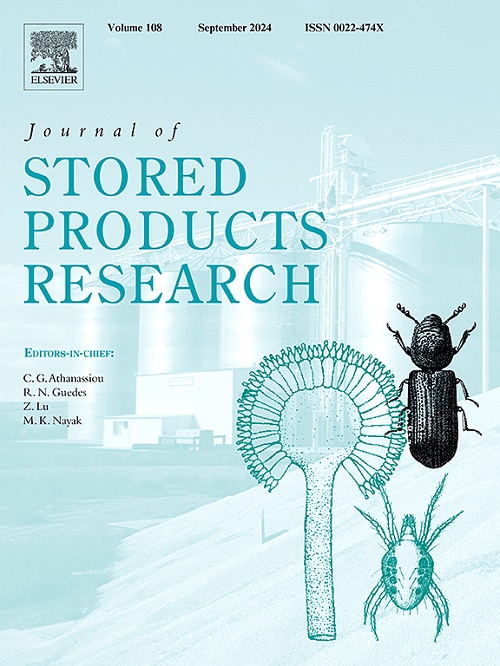Impact of gaseous ozone treatment on storability and quality of onion (Allium cepa L.) during bulk storage
IF 2.7
2区 农林科学
Q1 ENTOMOLOGY
引用次数: 0
Abstract
The increased storage life while maintaining the quality of the onion bulbs is crucial in the agriculture sector as it directly affects the marketability of the commodity. In the present investigation, gaseous ozone treatment was applied to a stored batch of 500 kg onion bulbs. During bulk onion storage, the fungal count increased from 4.28 ± 0.06 to 6.79 ± 0.23 log CFU/g, 2.86 ± 0.35 to 6.05 ± 0.12 log CFU/g and 2.87 ± 0.34 to 5.62 ± 0.27 log CFU/g, while the bacterial count increased from 1.90 ± 0.12 to 6.58 ± 0.32 log CFU/g, 1.15 ± 0.17 to 6.05 ± 0.18 log CFU/g and 1.19 ± 0.17 to 5.33 ± 0.04 log CFU/g for untreated, single-treated and periodically treated bulbs, respectively. This indicated that the ozone treatment controlled and reduced microbial count throughout storage. For a storage period of 120 days, periodic ozone treatment reduced rotting by 55.52 % compared to the untreated bulbs, while single treatment lowered rotting by 30.67 %. The change in pyruvic acid content with the storage period was significant for the treated and untreated bulbs. At the end of the storage period, it was found to be 12.61 ± 0.33 μmol/g F.W. for the untreated sample, 12.03 ± 0.60 μmol/g F.W. for the single treated sample, and 11.24 ± 1.01 μmol/g F.W. for periodically treated samples. Ascorbic acid content decreased with an increased storage period for all treatments, while phenols, flavonoids, anthocyanin content, and antioxidant activity increased significantly. Periodic ozone treatment is a viable fumigation method for extending shelf life and preserving bulb quality during storage.
气体臭氧处理对洋葱贮藏过程中贮藏性和品质的影响
在保持洋葱质量的同时延长洋葱的储存寿命对农业部门至关重要,因为它直接影响到商品的适销性。在本研究中,对一批500公斤洋葱球茎进行了气态臭氧处理。洋葱散装贮藏期间,真菌数量从4.28±0.06增加到6.79±0.23 log CFU/g、2.86±0.35增加到6.05±0.12 log CFU/g、2.87±0.34增加到5.62±0.27 log CFU/g,细菌数量从1.90±0.12增加到6.58±0.32 log CFU/g、1.15±0.17增加到6.05±0.18 log CFU/g、1.19±0.17增加到5.33±0.04 log CFU/g。这表明臭氧处理在整个储存过程中控制和减少了微生物数量。在120天的贮藏期内,臭氧周期性处理比未处理的球茎腐烂率降低了55.52%,而单一处理的球茎腐烂率降低了30.67%。处理和未处理球茎的丙酮酸含量随贮藏期的变化显著。贮藏结束时,未处理样品的F.W.为12.61±0.33 μmol/g,单处理样品的F.W.为12.03±0.60 μmol/g,周期处理样品的F.W.为11.24±1.01 μmol/g。抗坏血酸含量随贮藏期的延长而降低,酚类、黄酮类、花青素含量和抗氧化活性显著增加。定期臭氧处理是一种可行的熏蒸方法,可以延长保质期,并在储存期间保持球茎质量。
本文章由计算机程序翻译,如有差异,请以英文原文为准。
求助全文
约1分钟内获得全文
求助全文
来源期刊
CiteScore
5.70
自引率
18.50%
发文量
112
审稿时长
45 days
期刊介绍:
The Journal of Stored Products Research provides an international medium for the publication of both reviews and original results from laboratory and field studies on the preservation and safety of stored products, notably food stocks, covering storage-related problems from the producer through the supply chain to the consumer. Stored products are characterised by having relatively low moisture content and include raw and semi-processed foods, animal feedstuffs, and a range of other durable items, including materials such as clothing or museum artefacts.

 求助内容:
求助内容: 应助结果提醒方式:
应助结果提醒方式:


